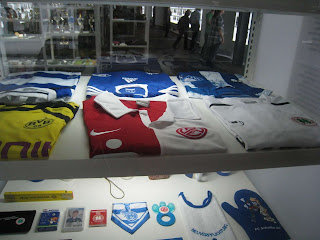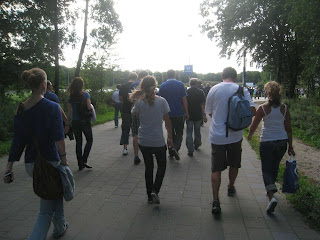Dortmund came into my life for the first time in 2005 when I read about the Dortmund Project. Facing the decadence of the industrial economy, because of globalisation process, the city of Dortmund together with private company ThyssenKrupp AG hired consulting McKinsey to design a new future for the city. It was done around the year of 2000 and the target was to create 70.000 new job positions until the year of 2010 and attract investment to develop new economies focused on Information Technology (IT), Micro-Electronic-Mechanical Systems (MEMS) and electronic logistic (e-log). At that time I got to know about the Dortmund Project it really impressed me how an industrial (old economy) city wanted to become in some years in a reference as modern high tech economy.
Five years later I ended up visiting Dortmund at the deadline of the project. The reason of my trip to Dortmund though wasn't to check if the Germans were following the deadline and making things happen, but my passion for football which I will explain later.
Before writing about Dortmund it's indispensable to write about the Ruhr area in which Dortmund is located.

The Ruhr region has a population over 7 million people making it the biggest urban agglomeration in Germany and one of the biggest in Europe. It had a key role on the economic development of Germany and was the heart of the industrial revolution with the coal and iron mines and development of siderurgy.
The Ruhr area was the base of Germany's industrialization hosting the heavy industry and as a result 27 of the 100 Germany's largest companies are based in this area.
The main cities in the Ruhr Area are: Dortmund, Essen, Bochum, Gelsenkirchen.
 |
| Winding tower of shaft 12 at Zollverein is the symbol of the Ruhr area |
The Ruhr Museum is located at the Zollverein Coal Mine Industrial Complex at the city of Essen, an UNESCO World Heritage Site. A former industry plant that was closed and almost sold to China, but now attracts turists with culture.
North Rhine-Westphalia is the name of the German state in which the Ruhr area is included and concentrate important cities like Cologne, Düsseldorf, Bielefeld and Bonn. And also it is the German state that host the highest number of the biggest German companies, like Lufthansa airline, Deutsch Post, Deutsch Telekom, Bayer, E.On, Henkel, RWE, ThyssenKrupp.
 |
| Dortmund U-Tower, former Dortmund Union brewery building, now a museum |
 |
| Central square |
Even though it sounds pretty much a grey city filled with abandoned siderurgies plant and coal mines, Dortmund and the Ruhr area nowadays present an appearence full of trees, parks and colors. Full of life and creativity expressed in the small details like the symbol of the city, a rhino with wings. Heavy, gangling, but always colorful, artistic and with a pinch of humor.
Bakery operating since 1848!!! Bread and more bread.
|
Dortmund, the city of endless flying Rhinos
One of those small details of Dortmund that got my attention was the architecture of the city. A tuned mix of the old and the new. The traditional in harmony with the modern. Somehow Dortmund could, maybe, be a portrait of nowadays' Germany. Preserving history and at the same time building up the future challenged by globalization and the modern economy.
 |
| Reinoldikirche on the left, from the 13th century. In the center a stylish subway station. |
 |
| Old German architecture |
 |
| Modern Glass+Steel architecture |
 |
| Cool subway station |
 |
| Skate park |
FOOTBALL DAY - FUSSBALL TAG / BUNDESLIGA
When in Vienna, Austria, during my first trip in Europe, I met a German that recommended me: "if you like football, you have to go to Dortmund to watch a match of the local team!".Dortmund's local team is one of the most popular, if not the most popular, in Germany. It is called Ballspielverein Borussia Dortmund 1909, or simply BVB.
As the name says the club was founded in 1909 in a local pub.
The German national league (Bundesliga) is the one with the highest average attendance in the world. Football is very popular in Germany and it couldn't be different in the Ruhr region.
Actually it's so big that it's part of the Ruhr culture. The birth and development of the football teams happened along with the regional economic development. Schalke 04 from Gelsenkirchen for example, the archi-rival of BVB, was founded by local miners on 1904. Although Gelsenkirchen has a population around 250.000, the club itself has more than 100.000 members and they play at the Veltins Arena frequently full with its 61.673 capacity and many fans all over the country.
In the North Rhine Westphalia State 5 teams are on the main league, Bundesliga, out of 18 teams making it the State of the country with the highest number of teams. An incrible rate of 28% of the main German teams!
1. Bayer Leverkusen
2. FC Köln
3. Borussia Dortmund
4. Borussia Mönchengladbach
5. Schalke 04
The same happen on the 2. Bundesliga, the second league, with 5 out of 18 teams from the State of North Rhine Westphalia.
1. Alemannia Aachen (2)
2. Fortuna Düsseldorf (2)
3. MSV Duisburg (2)
4. SC Paderborn 07 (2)
5. VfL Bochum (2)
 |
| Football jerseys at the Ruhr Museum |
 |
| BVBmobile |
Ballspiel Verein Borussia (BVB) / Borussia Dortmund
 |
| Old stadium and pitch side by side with the employed nowadays |
Signal Iduna Park is the name of BVB stadium, formerly known as Westfalenstadion before selling the naming rights. It is the largest football stadium in Germany and has the picturesque "Südtribune" (South tribune), a sector in the stadium where 24.454 supporters watch the match standing, making it the largest terrace in Europe and also known as the "Yellow Wall". During international matches it is converted to seating places reducing the stadium capacity. Playing in the Bundesliga it has an average attendance over 75.000, the highest in Germany and one of the highest in the world. Because of the history and football environment it has some nicknames like "the Temple" or "Colosseum".
 |
| The football temple - Westfalenstadion / Signal Iduna Park |
 |
| One of the entraces - everything organized even with the high attendance |
 |
| First view inside the temple |
The match I went was the opening first round of the 2010/2011 season against the good team of Bayer Leverkusen. Expectations were high for the beginning of the new season, for the debut of Michael Ballack at Leverkusen and on the Dortmund side a very young team.
The attendance of this match against Bayer Leverkusen for the first round of the Bundesliga was 73.300 and an average over 77.000 along this season.
Leverkusen won by 2:0 and curiously BVB ended the season as the German champion and it was its only home defeat.
 |
| Before |
 |
| Later |
 |
| Before |
 |
| Later |
Video: overview inside Signal Iduna Park before the match with Brazilian soundtrack
 |
| Show time |
Video: BVB supporters singing you'll never walk alone before the match start
Songtext:
When you walk through a storm
hold your head up high
and don't be afraid of the dark.
At the end of the storm there's a golden sky
and the sweet silver song of the lark
Walk on through the wind...walk on through the rain
through your dreams be tossed and blown.
Walk on...walk on...with hope in your heart
and you'll never walk alone
you'll never walk alone
Walk on...walk on...with hope in your heart
and you'll never walk alone
you'll never walk alone
Video: BVB line up
Video: teams entering in the pitch
Video: BVB supporters singing
 |
| Leverkusen won by 2 and it was the only home defeat! |
































































